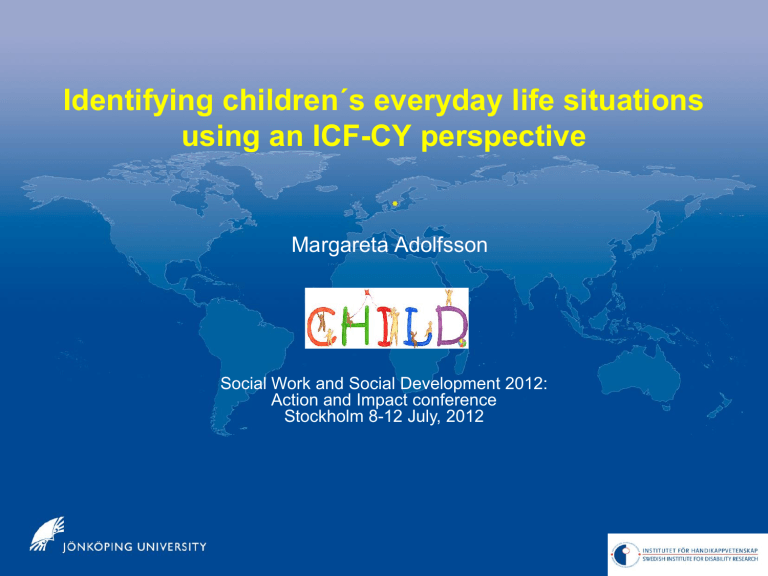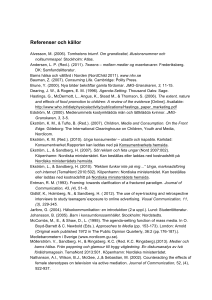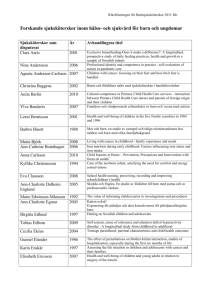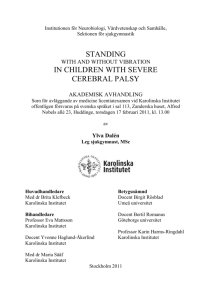presentation

Identifying children ´s everyday life situations using an ICF-CY perspective
Margareta Adolfsson
Social Work and Social Development 2012:
Action and Impact conference
Stockholm 8-12 July, 2012
Enhanced focus on participation in intervention planning
Overall goal
Opportunities for children with disabilities and their parents to express opinions during intervention processes
Missing
Structured model to identify child participation in everyday life situations
Aim of study
Parents’ and professionals’ pictures of everyday life situations to be considered in intervention planning
I nternational C lassification of F unctioning, Disability and Health
– C hildren and Y outh
ICF-CY model
dimensions of functioning
multidimensional descriptions of children´s life situations
interactive
children’s functioning in relation to context
“Dictionary for descriptions” – not classification of children
ICF-CY chapters focusing on participation
Life areas
1. Learning and applying knowledge
2. General tasks and demands
3. Communication
4. Mobility
5. Self care
6. Domestic life
7. Interpersonal interactions and relationships
8. Major life areas
9. Community, social and civic life
Steps to identify everyday life situations
Professionals’ views
297 professionals in education and early intervention services
Open-ended question
Questionnaire on ICF-CY categories
Parent’s perspectives
7 networks of children with severe disabilities 10-19 yrs
42 parents of children with or without disabilities 6-16 yrs
15 caregivers of typically developing children 3-5 yrs
Interviews
Results
Identification of everyday life situations
7 ICF-CY chapters (3-9)
2 age groups
0-6 yrs (younger), 7-17 yrs (older)
10 everyday life situations/age group
Younger - developmental milestones
Older - societal involvement
2 ICF-CY chapters most important
Self care
Major life areas
Partly different perspectives parents - professionals
Differences parents - professionals
ICF-CY categories identified as everyday life situations
Communication, unspec.
Walking and moving around
Hygiene
Dressing
Eating and drinking
Sleeping
Household tasks
Family relationships
School education
Engagement in play
Recreation and leisure
Younger
(0-6 yrs)
X
X
X
X
X
X
X
X
X
X
Older
(7-17 yrs)
X
X
X
X
X
X
X
X
Social
Recreation
Leisure
Future research
Include children and youth
Develop code sets, i.e. short lists of ICF-CY codes to discuss and explain participation restriction
Formulate names of code sets
Adaptations for different cultures
ICF-CY Developmental Code Sets for Children
2011. Ellingsen, K.E.& Simeonsson, R.J
I.
Birth to 36 months (0-2)
II.
Three through Five Years (3-5)
III. Six through Twelve Years (6-12)
IV. Thirteen through Seventeen Years (13-17) http://www.icf-cydevelopmentalcodesets.com/Home_Page.html
References – training on the ICF/ICF-CY
ICF training Beginner’s Guide http://www.who.int/classifications/icf/icfapptraining/en/index.html
Training in the ICF and ICF-CY (in Swedish) http://www.socialstyrelsen.se/publikationer2011/utbildningsmaterial-om-icf-icf-cy
The Canadian ICF Training Course (interactive) http://www.bcchildrens.ca/professionals/EducationTraining/ICF.htm
ICF Australian user guide version 1.0
http://www.aihw.gov.au/publication-detail/?id=6442467517
Pless & Granlund (Eds.) (2011). Handbok i att använda ICF och ICF-CY.
Studentlitteratur (in Swedish)
Thanks!
Adolfsson, M., Granlund, M., Björck-Åkesson, E., Ibragimova, N. & Pless, M. (2010). Exploring changes over time in habilitation professionals’ perceptions and applications of the International Classification of Functioning,
Disability and Health, version for Children and Youth (ICF-CY). Journal of Rehabilitation Medicine. 42(7); 670-678
Björck-Åkesson, E., Wilder, J., Granlund, M., Pless, M., Simeonsson, R., Adolfsson, M., et al. (2010). The International
Classification of Functioning, Disability and Health and the version for children and youth as a tool in child habilitation/early childhood intervention - Feasibility and usefulness as a common language and frame of reference for practice. Disability and Rehabilitation, 32(S1), S125-S138.
Adolfsson M., Malmqvist, J., Pless, M. & Granlund, M. (2011). Identifying Child Functioning from an ICF-CY Perspective.
Everyday Life Situations Explored in Measures of Participation. Disability and Rehabilitation. 33(13-14), pp. 1230 -
1244.
Adolfsson, M., Granlund, M. & Pless, M. (2012). Professionals’ views of children´s everyday life situations and the relation to participation. Disability and Rehabilitation, 34 (7) , 581-592
Adolfsson, M. (accepted) Applying the ICF-CY to Identify Children´s Everyday Life Situations: A step towards participation-focused code sets. International Journal of Social Welfare
Adolfsson, M., Björck-Åkesson, E. & Lim, C-I. (submitted). Code sets for everyday life situations of children aged 0-6:
Sleeping, mealtimes, and play. A pilot study based on the ICF-CY. British Journal of Occupational Therapy margareta.adolfsson@hlk.hj.se




